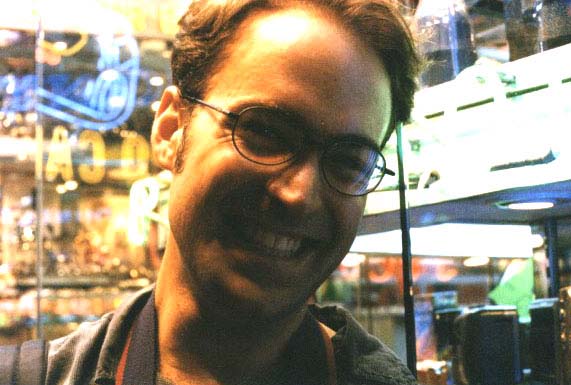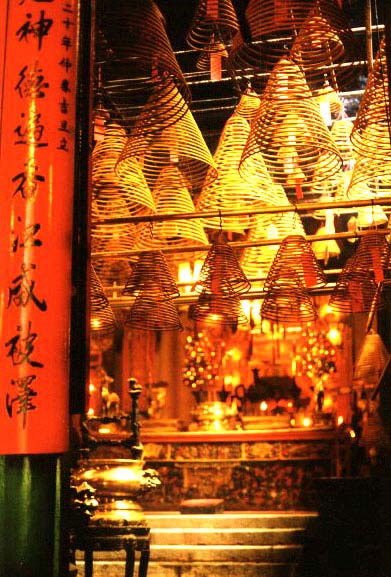 |
| Incense coils, Man Mo Temple |
Tuesday, November 25
Sheung Wan Walking Tour;
Reaching the Peak
The next morning began with a moment of confusion as I awoke to the sound of a muezzin making the call to prayer. I was briefly transported back to Cairo and Amman, my mind drifting to the cadence of his plaintive song. But this was Hong Kong, I remembered: there were no camels here and the air was too damp. Just up Nathan Road, it turns out, is the largest mosque in Hong Kong, used primarily by the city's Malaysian, Indonesian and Pakistani residents. I could barely make it out through the right side of my window. I guess I never imagined I'd wake up to Islamic prayers in Hong Kong.
The Man Hing Lung Guesthouse didn't have any breakfast available, so Susanne and I began the day at a local McDonalds, enjoying a traditional Hong Kong meal of Egg McMuffins and hash browns. I personally would have preferred some cereal or something less fast food-like, but at least McDonalds had the distinction of being perhaps the only eating establishment in Hong Kong where local prices were comparable to US prices. I might not have cared for what I was eating, but at least I could afford it.
The dark storm clouds of the preceding afternoon had been replaced by a sheet of damp, gray fog. Scattered showers were in the forecast for the day, so we brought our umbrellas along with our cameras this morning. Today would be our only full day in Hong Kong, so we decided to take the ferry to the island for a walking tour of Sheung Wan, Hong Kong's old historic district, before catching a ride to the top of Victoria Peak. I didn't have much of a sense whether this constituted a full day's worth of activities or not, so Susanne and I agreed not to make any definitive plans beyond that. But Susanne also had a friend from Denver living in Hong Kong, so tonight we'd try to track her down as well.
The Star Ferry was crowded with mid-morning commuters, all dressed in designer suits and sporting cellular phones. I couldn't imagine taking a ferry back and forth to work each day, but I suppose the down time on a slow boat might be a fine way to decompress after a hard day at the office. We followed the crowd off the ferry across Statue Square, a small park in the center of Hong Kong's financial district. The square once played host to numerous stone effigies of Britain's royal family, but the statues were carted away during the city's World War II Japanese occupation. They were eventually recovered but never reinstalled - British colonialism was on its way out. From here we had a 20 minute walk to Sheung Wan.
Susanne and I conveniently followed the double decker trolley line along De Voueux Road Central as our trail of bread crumbs to Sheung Wan. Apart from the preponderance of Chinese pictograms on billboards and signs, we could have easily been in New York or London as we wandered past Gucci, Fendi, Cartier, Rolex. It seemed every major player in the world of high fashion and shopping had a store along the road, in between entire blocks of international banks and luxury hotels. But down the alleyways to our left we saw a different story: thin passageways packed with market stalls and shoppers. We veered down one of these alleys to get a better look at what was available here: sheets of silk by the yard, Peking duck, vintage clothing, fake designer shoes. There also seemed to be a large number of stalls selling personalized wood block chops: stamps that might print a stylized character for your name, your zodiacal sign, etc. There must have been a chop shop for every two or three stalls along these thin markets. The people of Hong Kong had modern tastes indeed, but they were still very conservative, superstitious people. You never know when just the right chop might come in handy.
 |
| Hanging baskets in a fruit market, Sheung Wan |
Parallel rows of alley markets continued to appear as we worked our way west towards Sheung Wan. The Lonely Planet guide to Hong Kong contained a walking tour that would lead us through the winding streets of the district now best known for its dried herbs, antiques and hidden temples.
We entered Sheung Wan along Des Voeux Road before cutting left on Sutherland Street. There were no particular landmarks that announced our entry into the district apart from the conspicuous appearance of signs with drawings of sharks and birds' nests. Over the decades, this particular strip of Sheung Wan had grown into a wholesale goods market for restaurants. Herbs and roots of all shapes and sizes could be found in the many shops along these roads. But there are two real reasons why restauranteurs bring big money when they come to this neighborhood, and both of them were soup. Bird nest soup and shark fin soup are sophisticated delicacies in Hong Kong, and diners pay top dollar for the best soups they can get. Along the walls of the shops we could see giant dried shark fins, some as large as a meter in length. These yellowish, leathery strips would then be chopped up and used to make a broth. Similarly, in store windows we found fancy boxes of bird nests, most of which were small enough for you to fit two or three of them in the palm of your hand. Compared to the shark fins I found the notion of using nests in soup a little more difficult to grasp. Apparently each nest contained a bed of nettles collected by certain species of birds in southeast Asia. The birds secrete a glue-like liquid that they use to cement the nettles together. When heated in water, the secretions and the nettles impart a unique (and apparently highly cherished) flavor to the soup.
To much of the world, Hong Kong is known as the Fragrant Harbor, originally due to its steady trade in exotic perfumes. Nowadays that reputation is often pegged to the unfortunate stench of rotting marine life and harbor pollution. But Sheung Wan carried a fragrance of its own, a combination of the numerous ginseng shops, flower vendors, fish markets, and car exhaust. I hadn't really noticed Hong Kong's famous maritime stench during my stay here, perhaps because I'm used to the scent of stagnant sea water from having grown up on an island off the coast of Florida. But Sheung Wan's smell was quite distinct; neither pleasant nor unpleasant, merely unique. There have been certain places I've encountered that have possessed unique and memorable smells: the woody incense of Kathmandu and the melange of roasting sweet potatoes and tobacco of Cairo both come to mind. Sheung Wan, it appeared, might now add itself to this short list. I wonder if I read this again in 10 years if I'll still be able to remember it.
As we left the ginseng district we wound our way up a steep cobblestone road to the competing sounds of temple bells and construction equipment. Two old women sat at the bottom of a series of high steps that appeared to lead to one of the local Taoist shrines, the Pak Shing Temple. I looked up towards the top of the steps and saw the pagoda-like entrance to the small temple. One of the women motioned to us, signaling we should climb up and investigate. Feeling somewhat emboldened by her gesture, I motioned towards my camera to see if they would mind if I took their picture. The old women barked at me in Cantonese, causing me to bow my head in embarrassment. Apparently we could visit their shrine but not take their picture.
We climbed the steps and crossed through a small courtyard. Long yellow spirals of some unknown material hung from the ceiling. There was a picture of similar spirals on the cover of the Lonely Planet book, but we hadn't figured out what they were. Hopefully we could get a better look at some point. The shrine itself was made up of two small chambers, both full of tall candles and offerings. Chinese traditionally believe in ancestor veneration, which often manifests itself in the form of leaving offerings at shrines. In front of each temple alter I could spot a variety of gifts to the dead: fresh oranges, coins, pictures of new grandchildren, even bottles of beer. An older gentleman was sitting below the main altar, chanting in Cantonese while lighting a tall candle. The entire temple wasn't much larger than a small kitchen, so I felt as if we were getting in his way, so we decided to head out. A young man in a suit squeezed past us through the entry way, carrying a large plastic bag. I wondered what he had to offer to his ancestors that day.
Further up the road we reached the beginning of Sheung Wan's antique district. There were few bargains to be had here: most shops had the reputation of carrying either museum-quality pieces or junk, so if you wanted to shop you had to bring a heavy wallet. Susanne and I decided to poke our heads into one shop. It was a dusty mess, with piles of antiques rising up to the ceiling, sometimes even obstructing the thin aisles through the shop. The family owners huddled in the corner, chatting loudly and eating rice washed down by large bowls of shark fin soup. The shop apparently specialized in large pieces, from ceramics and vases to intricately carved wood paneling. With my backpack slung over my right shoulder I felt like a bull in a china shop (a bull in a Chinese shop, perhaps?), so I delicately made my way outside, hoping I wouldn't have to commit my life savings to having accidentally shattered a Ming vase.
The Lonely Planet guide had mentioned a particular coffin shop in this neighborhood that sounded as if it would be of interest. Apparently the shop specialized in a traditional form of rounded coffins each built out of four logs of wood. A few shops down to the left of the antique store I noticed several large wooden trunks outside of a doorway. We briefly peered inside and saw several rows of coffins, all in various stages of assembly. I had hoped for something a little more macabre that a woodworking shop, but there really wasn't much more to it. We decided to continue down the road.
As we paused for a moment at the top of a hill I realized I was covered in sweat. We had hoped that Hong Kong would be a well deserved respite from the heat and humidity of Southeast Asia, but this November it was much warmer than usual, courtesy of El Nino. Just across the road I could see the Man Mo temple, one of the oldest Confucianist temples in Hong Kong, but Susanne and I agreed to head down a long row of steps to a McDonalds first. Man Mo wasn't going anywhere and we really needed to sit down for a few minutes. To the left side of the steps were several rows of antique dealers and souvenir shops. In some stores I'm sure the distinction between heirloom antiques and cheap souvenir reproductions was a fine one indeed, but at least two or three of the shops appeared to be the type that would only buzz you in if you flashed your Gold Card at the door.
Inside the McDonalds we grabbed a couple of Cokes and sat for a while, listening to a strange audio loop that appeared to be promoting a new Happy Meal or something. I had no idea what the actual promotion was about because it was in Cantonese, but we had a difficult time drawing our attention from it because of the accompanying sound effects, straight out of a 1960s Hanna Barbera cartoon. I honestly expected the voiceover guy to shout out "Hey Booboo!" or something. The loop repeated itself a dozen times or so before we decided to get out of there in order to save ourselves from losing our minds. (I can even here it right now as I write this. Make it stop!...)
I didn't realize how steep the climb was back to the Man Mo temple until we attempted to head back the other way. Apparently this was Ladder Street, an appropriate name for such a disturbingly steep ascent. Having finally cooled down in the McDonalds, we didn't want to break out into a sweat again so quickly, so we made the climb in stages, pausing at some of the antique stores on the way up. One shop features a massive Khmer statue of Vishnu, at least seven feet tall. I didn't see the price tag, but it made me think of all of those mutilated statues at the south gate of Angkor Thom, whose heads had been removed and smuggled to Bangkok for sale on the antiques black market.
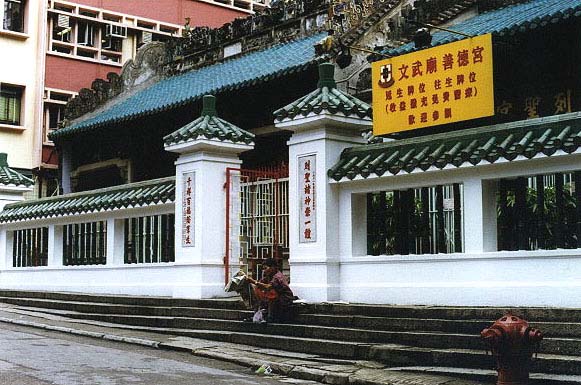 |
| Man Mo temple, Hong Kong |
The Man Mo temple appeared as an undistinct, squat building from the outside. From the pagoda-like design it was obvious this structure was a temple, but compared to the many other houses of worship we had seen during our trip this temple seemed surprisingly unassuming. The inside, though, was far more impressive; a dark, smoky chamber filled with burning candles and incense, with large golden shrines built up along the sides of the room. Man Mo is considered one of the oldest temples on the island, though no one is exactly sure just how old it is; the only thing people can agree on is that it was a thriving temple when the British first arrived on the island. Man Mo is dedicated to the worship of two deities: the civil god (Man) and the war god (Mo), both of whom were based on real Chinese men. The civil god is believed to be a representation of a successful Chinese statesman from the 3rd century BC, while the war god is attributed to Kuanti, a 2nd century AD warrior.
Near the center of the temple I once again found several dozen hanging yellow coils, ranging in size from several inches to several feet long. I decided to give them a closer inspection but as I approached one of the larger coils I was momentarily overcome with think, acidic smoke. My eyes burned as my nose was filled with a powerful, sweet scent. The coils, I now realized, were enormous incense sticks that burned every so slowly, around and around. Incense as sacred, yet ephemeral artwork.
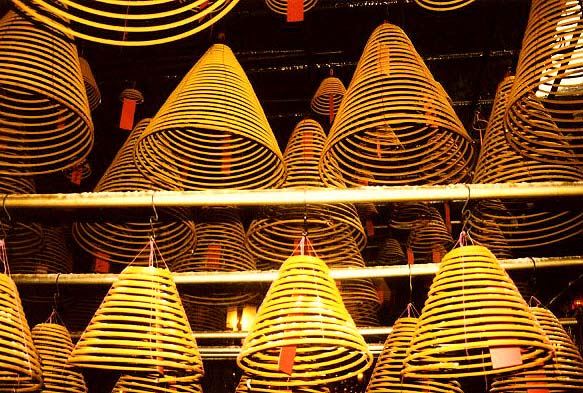
I popped my head outside the temple and noticed it was beginning to drizzle. The main shrine was hot and uncomfortable, so I allowed the drops of rain to land on my face and cool me. The stiff-looking temple guard, perched in a small enclosure, briefly let down his cold visage and smiled, motioning his hand in a gesture of approval. Susanne was taking pictures of the coils inside the temple. I doubted there was enough light to capture the scene, but I hoped for the best.
No trip to Hong Kong is complete without a visit to the top of Victoria Peak, with its stupendous view of the island 1200 feet above the city. As the rains came and went, I knew there was no way we would be treated with a clear view of Hong Kong, but nonetheless felt it was important to make the pilgrimage to the top. We cut back down to Queen's Road Central and headed east towards Central, where we hoped to find the terminus for the tram ride to the top. Queen's Road was packed with business people returning to work after lunch. The crowds were amazing; I was instantly reminded of midtown Manhattan. In the heart of the Admirality business district we passed a large upmarket ginseng store that displayed samples of its various dried herbs and animal parts, each with their peculiar medicinal purposes. While men in business suits purchased large boxes of ginseng, Susanne and I marveled at the display: dried seahorses, powdered cow gallstones, shark fins, even goat testicles. It was a quick introduction to traditional Chinese medicine, though probably not appropriate show-and-tell for the animal rights crowd.
We headed up D'Aguilar Street through Lan Kwai Fong, a dense collection of bars and pubs, largely regarded as an expat's ghetto. Beyond the bars the road the city became quiet as we reached an area between Government House and the zoological park. There really wasn't much to see here and we were feeling pretty sweaty at this point - I could see Susanne was eager to get to the tram. Within a few minutes, after briefly getting lost alongside a busy road, we found the terminus and paid the HK$21 for the round-trip ticket. The tram brought us up at a severe angle, with the crowded streets of Hong Kong passing further and further behind us. I really couldn't see what was ahead of us for there was a large growth of trees and rocks obscuring the view. Eventually the trees thinned out and I could see the Peak - not the peak of Victoria, per se, but the Peak Galleria, an observation deck and shopping mall shaped like a metallic postmodern pagoda. Hong Kong had gone out of its way to capitalize on the number of people who wanted to visit the summit of Victoria Peak by developing the Galleria, despite complaints from traditionalist who said it would be to crass and commercial. Well, it is crass and commercial, as far as everyone seems to be concerned, but it hasn't stopped thousands of people from visiting it every day, including us.
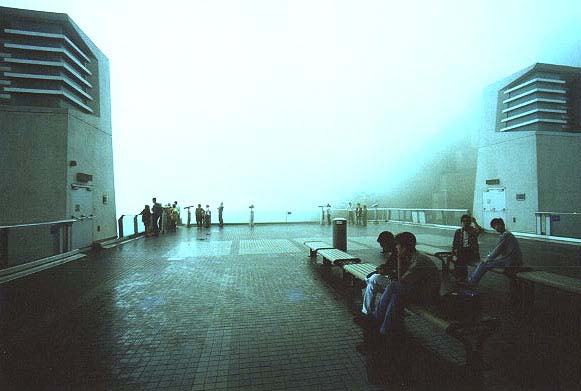 |
| A foggy day on the Victoria Peak viewing platform |
After disembarking the tram we climbed up to the observation deck, a large metal and stone slab where hundreds of people can cram at once and admire the view. The first thing I noticed was the fog. No, not fog. Clouds. The peak was completely enshrouded with dark gray stormclouds, whizzing through the air at 20- to 30 miles per hour. Run-of-the-mill fog can be a creepy experience, but this was down right surreal. We were standing in the middle of an actual storm cloud, thick as smoke. My glasses were quickly coated with a layer of moisture. We managed to keep our camera lenses clean as we tried to capture the view of the city below, in between bursts of clouds. I had seen pictures of this view of Hong Kong and had always thought that they were taken with wide-angle lenses - the buildings always seemed so distorted around the edges. Now, as I stood above the countless highrises below, I realized that these pictures needed no trick lenses, for the sheer angle of looking down upon the city caused a distortion of the senses. We're so used to seeing cityscapes from head-on, it's a bit unnerving to experience one from above. Clouds or no clouds, this was truly one of the greatest city views in the world.
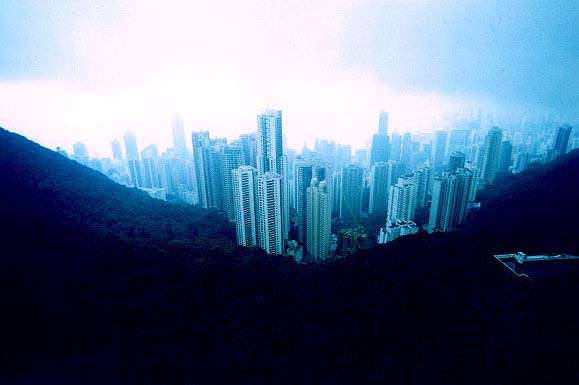
I could have easily spent hours here gazing down upon Hong Kong, enveloped in flowing sheets of black and gray mist, but Susanne and I were both a little worn by this point. We retreated to a cozy restaurant where I hoped we could relax for a while, but we were soon scared off by the menu - HK$100 iced tea, HK$300 sandwiches. I had hoped we could get through the rest of our trip without having to cash any more traveler's cheques, and there was no way we'd want to blow 75 bucks just for the pleasure of eating on top of Victoria Peak. We returned to the main Galleria and found a small cafe that had croissants and coffee for HK$30 - much more reasonable in my book. I read a copy of the South China Post while Susanne attempted to call her friend Jennifer and see if she was available for dinner that night. After leaving a message on Jennifer's machine, we decided to return to our room and rest. If Jennifer were available we'd hang out with her. Otherwise there were some free musical events at the Hong Kong Cultural Centre, just down the street from our guesthouse.
Back in Kowloon, Susanne managed to get ahold of Jennifer, who had plans for later in the evening but was available for dinner. We met her inside the Peninsula Hotel at 7pm. Susanne had introduced me to Jennifer two years ago in Denver, when the two of them were working for the Encore cable network. Jennifer jumped on an opportunity to transfer to Hong Kong last year, where she's lived ever since. Once we found each other, Jennifer suggested we first visit Felix, one of Hong Kong's hippest restaurants, which happened to be on the top floor of the hotel. I didn't see what the big deal was, especially if we weren't going to eat there, but Jennifer insisted we check it out.
The restaurant itself was a typical postmodern art deco joint, with lots of neon and marble. "I think you may want to go to the bathroom while we're up here," Jennifer said to us, a devilish smirk on her face. I had no idea why she had dragged us up here, but I agreed to visit the men's room while she and Susanne went the other way. Inside I found a similar marble motif, but I didn't see any toilets. A restroom steward smiled at me and pointed me towards a wide bay window, where I found a row of cylindrical brass objects protruding three feet from the floor. These were the urinals, pressed right up against the window. It was the strangest restroom experience I've ever had, standing right against a bay window, 100 floors above the ground, relieving myself in this little brass contraption that was so small it made me feel like I was whizzing right into Hong Kong harbor itself. Fortunately, there were no tall buildings between me and the water, so no one could peer back and observe me, but the experience was still discomforting to say the least. Back out by the restaurant, Jennifer eagerly awaited my impression of the restroom. "I wish I had taken a picture," I said.
The three of us caught the MTR to Wanshai, where we had dinner at a trendy noodle shop. The restaurant reminded me of Seattle. There were a good range of Asian noodles on the menu, along with french fries, buffalo wings, and all the other staples of Nouveau-Cantonese cuisine. Dinner was a little rushed, but the food was tasty, if not authentic. Since this was our last meal in Hong Kong, I was glad we didn't blow it on just another Pizza Hut.
After dinner, we caught a cab and went to Lan Kwai Fong, Central's pub district. Jennifer was meeting friends here later on, and we were within a short walk to the Star Ferry terminal. The Lan Kwai Fong scene was just beginning to pick up, with large groups of expats in suits standing outside bars with drinks in their hands. But tomorrow was going to be a long day, so common sense got the best of us as we walked up Queen's Road Central to catch the ferry back to Tsim Sha Tsui. We strolled through Statue Square, marveling at the Bank of China building in the background. We tried to get some pictures of the night scene but knew that our film was too slow to capture it well. So once we got back to our hotel we grabbed a roll of 1000-speed film Susanne had been saving and hit the streets.
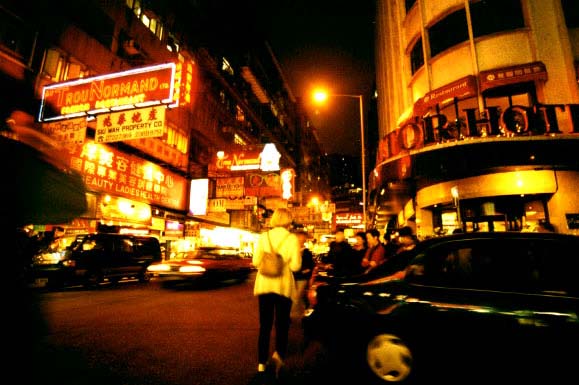 |
| Cornwall Avenue, Kowloon |
Hong Kong is a marvelous place at night, so alive with light and color. We wandered up and down Nathan Road and its surrounding thoroughfares, hoping we could capture Hong Kong nightlife on film. Just around the corner from the guesthouse we found Cornwall Avenue. Susanne wanted to get a picture of her namesake road; its multitude of neon signs made it an easy target. I really wish we could have spent a few more days in Hong Kong, but as we wrapped up our evening, taking those final pictures along Nathan Road, I felt totally at ease, ready to go home. Like Cambodia and Laos, Hong Kong had been good to us; I knew I would miss this place.
